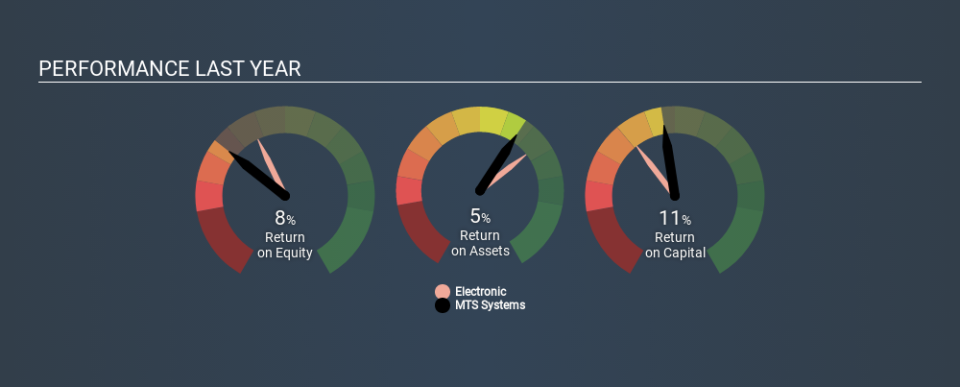Evaluating MTS Systems Corporation’s (NASDAQ:MTSC) Investments In Its Business

Today we'll look at MTS Systems Corporation (NASDAQ:MTSC) and reflect on its potential as an investment. To be precise, we'll consider its Return On Capital Employed (ROCE), as that will inform our view of the quality of the business.
First up, we'll look at what ROCE is and how we calculate it. Second, we'll look at its ROCE compared to similar companies. Then we'll determine how its current liabilities are affecting its ROCE.
Return On Capital Employed (ROCE): What is it?
ROCE measures the amount of pre-tax profits a company can generate from the capital employed in its business. In general, businesses with a higher ROCE are usually better quality. Ultimately, it is a useful but imperfect metric. Renowned investment researcher Michael Mauboussin has suggested that a high ROCE can indicate that 'one dollar invested in the company generates value of more than one dollar'.
So, How Do We Calculate ROCE?
The formula for calculating the return on capital employed is:
Return on Capital Employed = Earnings Before Interest and Tax (EBIT) ÷ (Total Assets - Current Liabilities)
Or for MTS Systems:
0.11 = US$116m ÷ (US$1.3b - US$270m) (Based on the trailing twelve months to December 2019.)
Therefore, MTS Systems has an ROCE of 11%.
See our latest analysis for MTS Systems
Is MTS Systems's ROCE Good?
When making comparisons between similar businesses, investors may find ROCE useful. It appears that MTS Systems's ROCE is fairly close to the Electronic industry average of 11%. Separate from MTS Systems's performance relative to its industry, its ROCE in absolute terms looks satisfactory, and it may be worth researching in more depth.
In our analysis, MTS Systems's ROCE appears to be 11%, compared to 3 years ago, when its ROCE was 7.5%. This makes us think about whether the company has been reinvesting shrewdly. You can click on the image below to see (in greater detail) how MTS Systems's past growth compares to other companies.
When considering this metric, keep in mind that it is backwards looking, and not necessarily predictive. ROCE can be misleading for companies in cyclical industries, with returns looking impressive during the boom times, but very weak during the busts. ROCE is only a point-in-time measure. Since the future is so important for investors, you should check out our free report on analyst forecasts for MTS Systems.
What Are Current Liabilities, And How Do They Affect MTS Systems's ROCE?
Liabilities, such as supplier bills and bank overdrafts, are referred to as current liabilities if they need to be paid within 12 months. Due to the way the ROCE equation works, having large bills due in the near term can make it look as though a company has less capital employed, and thus a higher ROCE than usual. To check the impact of this, we calculate if a company has high current liabilities relative to its total assets.
MTS Systems has current liabilities of US$270m and total assets of US$1.3b. As a result, its current liabilities are equal to approximately 20% of its total assets. Current liabilities are minimal, limiting the impact on ROCE.
What We Can Learn From MTS Systems's ROCE
Overall, MTS Systems has a decent ROCE and could be worthy of further research. MTS Systems looks strong on this analysis, but there are plenty of other companies that could be a good opportunity . Here is a free list of companies growing earnings rapidly.
MTS Systems is not the only stock insiders are buying. So take a peek at this free list of growing companies with insider buying.
If you spot an error that warrants correction, please contact the editor at editorial-team@simplywallst.com. This article by Simply Wall St is general in nature. It does not constitute a recommendation to buy or sell any stock, and does not take account of your objectives, or your financial situation. Simply Wall St has no position in the stocks mentioned.
We aim to bring you long-term focused research analysis driven by fundamental data. Note that our analysis may not factor in the latest price-sensitive company announcements or qualitative material. Thank you for reading.


